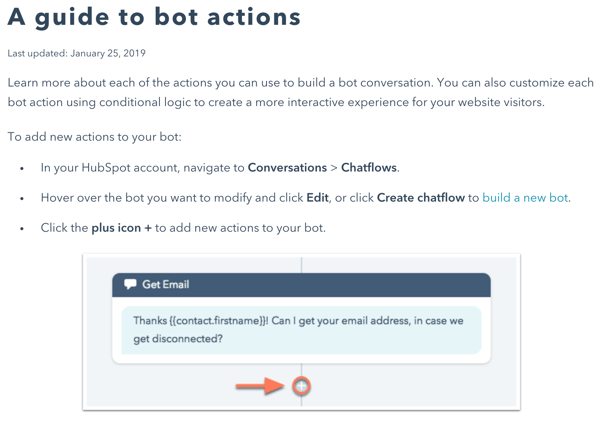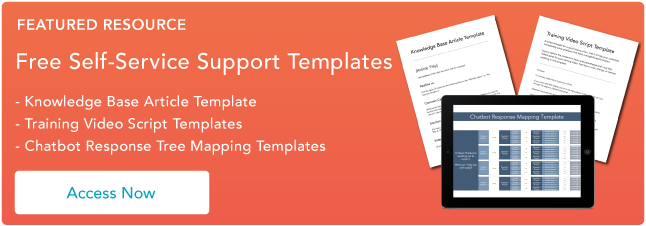Book of Knowledge Written Answer Template
Humans are — or aspire to be — self-sufficient creatures. We like to solve problems on our own and feel that personal sense of accomplishment when we do. Asking for help can sometimes feel like giving up. This isn't exactly the best news for someone in customer service, but it doesn't mean your job is becoming obsolete. Rather, it's evolving to fit the changing needs of customers. In fact, this could make your job feel even more valuable. Instead of constantly being on the phone, monotonously answering the same basic questions over and over, you can have more variety in your daily workload. One way in which customer service has evolved is with the development of knowledge bases. Knowledge bases are online databases that store information about a specific company, their products or services, or related industry topics. The data is either collected and stored through artificial intelligence or manually uploaded by expert contributors. A company's knowledge base can provide valuable information to customers, prospects, and even employees. You can include important facts about each department, directions for product or service usage, FAQs, and original content that can provide in-depth solutions. HubSpot's knowledge base helps us better serve and delight our customers by helping them access the solutions they need 24/7. Knowledge bases have also decreased the need for customers to search for questions on search engines. They can simply search the same question on your company's knowledge base, knowing the answer will exist in relation to the appropriate product or service. It's evident knowledge bases are an invaluable resource to both your company and your customers. But, how do you go about creating one? When a customer is looking for a solution to a problem, your knowledge base should make it as easy as possible to find answers. It's important that your knowledge base articles not only contain the solution that the customer is looking for, but is also formatted in a way that makes the answer clear and obvious. When writing new articles for your knowledge base, check out this guide for writing effective knowledge base articles. Knowledge bases are mainly for your customers and prospects, and not internal stakeholders. Thus, the language being used in the titles and articles should be simple, clear, and concise. When choosing titles, put yourself into the customer's shoes. What kinds of topics would they search for? What's their expected difficulty level in terms of knowledge on the product or service? Write titles based on this information. It's also helpful to use search-engine-optimized keywords in the title to attract more search volume. It's inefficient to have more than one article for the same topic. Not only does this split traffic between multiple articles, but it can get confusing for customers if they have to keep switching back and forth between multiple pages to find all the information they need. If you gain more information on a topic, do a keyword search to see if there are any articles with similar keywords. If so, you can update the existing article with more information. This will make the article more all-encompassing so readers can gain all the information they need from a single source. Knowledge bases aren't just for searching. While many customers will search specific questions to solve problems, they may also use the database as a way to browse through related topics. This means your articles should be categorized by sections and sub-sections. For example, on HubSpot's knowledge base, you can search by HubSpot product, the type of resource, or a variety of topics, such as Blog, Dashboard, Emails, Integrations, and Sales Templates. This keeps the knowledge base organized and ensures every article has a place and a purpose. Sometimes, an article can get pretty long, especially if you've updated it with added information. Dedicated customers will scroll until the end when they want an in-depth, complete understanding of the problem and solution. However, the sheer length of an article could deter some readers. So, for longer articles, consider adding a table of contents. This will help people find the sections of the article that they're specifically interested in and skip any information they don't need. Start off the article by stating what the problem is, for scenarios that are problem-solution based. Not all knowledge base articles are meant to solve problems; some may just explain how to complete a task. In those cases, you can skip this step. Identify what the symptoms of the problem are to clearly relay what customers should be looking for. For example, list what error messages should be popping up if the problem does exist. You want to use basic language and make it as clear and concise as possible. The briefer this section is, the better, as people reading will likely be looking to get to the steps to solve their problem quickly. After stating the problem, you should immediately jump into showing readers how they can solve the problem. Layout this section in easy-to-read steps that can be read and followed in succession. You want to make sure the steps actually solve the problem they claim to solve. If the problem can't quite be solved, the steps can help eliminate potential causes or reveal what the root problem is. You'll want to lay out steps specifically for articles that are solving problems or showing how to accomplish a task. For comprehensive guides, you might not need to utilize steps. Instead, you can divide up the text by explaining different aspects under separate headers. You should end the article by describing what the solution is. After all, since not every problem can be completely resolved, the solution may be an improvement of the problem or an update of a product to avoid a former glitch. If needed, you can explain why a permanent solution couldn't be attained but that the solution laid out is the best case scenario for improving their situation. If there's no direct solution, or if the end result is self-explanatory, this step may not be needed. Instead, you can reiterate in the final step or paragraph that you've reached the end and that the task has been achieved. You never know if you've completely exhausted a topic for interested readers. Rather than making them browse through related articles on their own, you can link some of your other articles at the bottom or side of the article. This will help customers gain a more well-rounded education on the topic at hand. And, it helps get more eyes onto the articles you and your team worked hard to create. The more your readers use your knowledge base, the more they'll trust your organization as a source of accurate information. These steps can help you create knowledge base articles that are effective and clear. However, not every article will be structured in the same format. Articles can vary in layout and design depending on the solution they're providing. The structure of a knowledge base article plays a major role in the piece's clarity and appeal. Customers are looking for specific and concise answers, and don't want to waste time scrolling through an essay to find it. Utilizing the common knowledge base article templates can play an instrumental role in determining the effectiveness of your self-service customer support. Source: HubSpot Academy How-to articles are typically brief. They show you exactly what steps to take to complete a specific task or perform a certain function. This is usually the type of knowledge base article that helps visitors solve problems they're facing with their products. How to [Name of Task] Applies to [Your Appropriate Products] [Brief Description of Problem, if Needed] [Brief Description of Solution, if Needed] Related Articles: [Three to six articles with links] Source: HubSpot Academy FAQ articles include a list of questions about the same, related topic on a single page. This includes general and tool-specific questions. They're usually all listed at the top in a table of contents with anchor links that allow you to jump down the article to the specific question you need to be answered. [Topic Name]: Frequently Asked Questions Applies to [Your Appropriate Products] [Brief Description of Topic] Table of Contents: General: [Tool-Specific Category 1] [Tool-Specific Category 2] [Etc.] General: [Question 1] [Answer 1] [Question 2] [Answer 2] [Etc.] Related Articles: [Three to six articles with links] Source: HubSpot Academy Tool description articles give a short description of what a specific tool or function is. Rather than answering questions or laying out steps, it tells you exactly how something works. [Tool or Function] Applies to [Your Appropriate Products] [Brief Introduction of Tool or Function] [Description of Tool] [Final Tips/Information to Note about the Tool] Related Articles: [Three to six articles with links] Source: HubSpot Academy User guide articles are long, comprehensive guides that cover an entire tool or function. Similar to an instruction manual, they include information on using every single feature to give you a well-rounded education on the tool or function. A Guide to [Tool or Function] Applies to [Your Appropriate Products] [Brief Introduction of Tool or Function] [Main Feature 1: Description] [Main Feature 2: Description] [Etc.] Related Articles: [Three to six articles with links] Source: HubSpot Academy Quick answer articles highly resemble user guide articles. They, too, are long, comprehensive guides that cover an entire tool or function. However, the difference is that quick answer articles include a table of contents in the form of anchor links -- like FAQ articles -- that allow you to jump down the article to the specific topic you want to learn more about. A Guide to [Tool or Function] Applies to [Your Appropriate Products] [Brief Introduction of Tool or Function] Table of Contents: [Tool-Specific Category 1]: [Tool-Specific Category 2] [Tool-Specific Category 3] [Etc.] [Tool Specific Category 1]: [Section 1] [Description] [Section 2] [Description] [Etc.] Related Articles: [Three to six articles with links] It's always helpful to include screenshots as examples for any tools, functions, steps, or descriptions that may be confusing to explain in words. Also, by showing your text alongside a visual, readers can follow along on their own product while reading your knowledge base and compare their progress. Still have some questions about knowledge bases? For more information, read the benefits of a knowledge base. 
What Is a Knowledge Base?
8-Step Guide to Writing Effective Knowledge Base Articles
Featured Resource: Knowledge Base Article Template
 Download the Free Template Now
Download the Free Template Now 1. Select simple titles using target keywords.
2. Only have one article per specific topic.
3. Categorize articles for easier browsing.
4. Include a table of contents, if needed.
5. Describe the problem, if applicable.
6. Relay the steps to accomplish the task at hand.
7. Announce what the solution should be.
8. Offer other article links for further reading.
Knowledge Base Article Templates
1. How-To

Template:
2. FAQ

Template:
3. Tool Description

Template:
4. User Guide

Template:
5. Quick Answers

Template:


Originally published Mar 14, 2019 8:00:00 AM, updated January 25 2021
Book of Knowledge Written Answer Template
Source: https://blog.hubspot.com/service/knowledge-base-article-templates